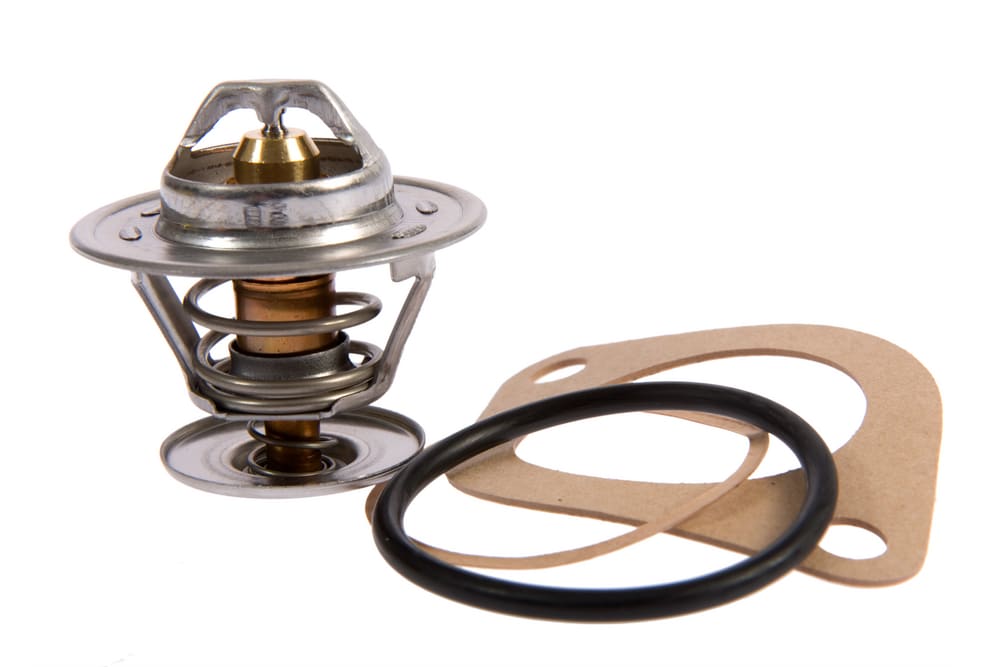

A car thermostat regulates the flow of coolant through the engine and is an incredibly important player in the operation of your vehicle’s engine. You may hear the phrase “the thermostat was stuck open or closed.” When the engine has been sitting for a while and is not warm, the thermostat will be closed. Once the engine is running and reaches a certain operating temperature, a sensor inside the thermostat will cause it to open, allowing coolant to flow to and from the radiator, decreasing the temperature so it can be recirculated through the engine again. This constant flow (in conjunction with several other cooling system components) keeps your vehicle’s engine functioning at the optimum temperature.
The opening and closing of the thermostat at the correct time are critical to maintaining proper engine temperature. In the event the thermostat happens to become “stuck” closed, there is no way for coolant to be circulated through the radiator and eventually back through the engine, which could cause the Coolant Temperature Warning Light to illuminate as well as extremely hot engine temperatures. Likewise, if the thermostat is “stuck” open, the flow of coolant is constant, it results in the vehicle’s engine temperature never reaching an optimum level of heat, creating performance problems and accelerating the wear-down of parts. There are 4 common symptoms associated with a bad or faulty car thermostat.
1. Hot Engine Temperature & Overheating
The first and potentially most alarming symptom of a bad car thermostat, or a “stuck closed” thermostat, will be the temperature gauge never leveling off within the first 15 minutes of starting your vehicle and instead slowly going from cold to too hot. This is often the first sign that the thermostat is not functioning properly. However, an overheating car could be caused by many things such as low coolant, a bad water pump, or potentially many other things. It is best to have a certified mechanic check out your car, as overheating your car can ruin your engine.
2. Low Temperature Engine
The next symptom of a bad car thermostat is when a thermostat is stuck in the open position. When a thermostat is stuck open, it constantly pushes coolant into the engine and causes a lower operating temperature. Your temperature gauge will show a needle that barely increases or remains at the lowest setting. This will reduce engine efficiency and increase emissions over time, as well as accelerate the deterioration of parts.
3. Inconsistent Temperature Fluctuations
Another sign of a bad car thermostat is inconsistent temperature fluctuations. These can occur and cause dramatic spikes and drops in temperature that eventually lead to poor engine performance and reduced gas mileage. In this case, you may see the temperature abnormally low at one point and, shortly after, climb to an abnormally high level. The thermostat itself isn’t stuck in any one position, but it will still produce false readings and cause issues with coolant regulation. This could be the thermostat sticking in one position longer than it should before returning to the open or closed position it should be at given the temperature of the coolant.
4. Thermostat Housing Area Coolant Leaks
Another symptom of a faulty car thermostat may be leaking coolant, which can occur when the thermostat does not allow coolant to flow when stuck in the closed position. Finding coolant leaks can be a bit tricky at times. This can be noticeable in a variety of locations, most commonly around the thermostat housing. It can eventually cause other coolant hoses to leak as well, often resulting in coolant leaking on the ground under your vehicle.
Thermostat replacement is a fairly inexpensive repair to make to your vehicle, preventing potentially thousands of dollars in engine damage due to excessive heat. Make sure to purchase a quality replacement thermostat if a replacement is needed to limit troubles in the future. If any of the above symptoms sound familiar to you, it may be time to have an expert mechanic diagnose your vehicle.



